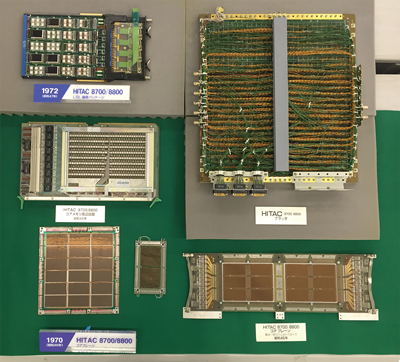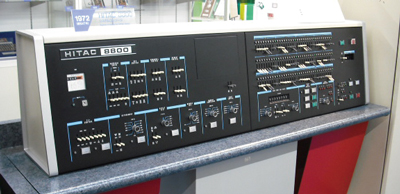

- Home >
- Artifacts of IP Heritage >
- 2015 >
- HITAC 8800 Components
HITAC 8800 Components


| Manufactured in | 1972 |
|---|---|
| Manufactured by | Hitachi, Ltd. |
| Owner | Hitachi, Ltd. |
| Location of historical materials | Hitachi, Ltd. 292, Yoshidacho, Totsuka-ku, Yokohama-shi, Kanagawa-ken, 244-0817 Japan |
| Visitor information | Not open to the public (Ask for a visit) |
| Contact | https://www.hitachi.co.jp/products/it/portal/museum/ |
A national project was initiated in 1967 to develop an ultra-high-performance computer, and Hitachi was asked to play a central role in its development. The project assembled the best of domestic technology and drew on the combined talents of the participants, with the assistance and cooperation of academia, government, and industry. The ultra-high-performance computer was completed in 1972. Hitachi made use of the resulting technology to commercialize the HITAC 8800 and 8700.
The HITAC 8800/8700 adopted a number of computer architecture advances, such as Japan’s first 32-bit virtual addressing system and a ring protection method of protecting memory. A core memory unit was used as the main memory and could be upgraded to 8 MB, which was very large at the time. The CPU included an internal bipolar IC buffer memory to speed up arithmetic processes. By using up to four CPUs, it was possible to construct a multiprocessor architecture sharing a main memory unit. The HITAC 8800/8700 also achieved buffer memory control with multiprocessors for the first time.
As the flagship model of the HITAC 8000 series, the HITAC 8800 had a Gibson mix time of 200 to 300 ns, which was the fastest for a domestic machine at that time and among the top performers in the world. The HITAC 8800 was used for various types of scientific and engineering computations at the Computer Centre of the University of Tokyo, the numerical forecasting system at the Meteorological Agency, and other facilities.
The HITAC 8800 components that survive are a logic package, a core memory unit and its peripheral circuitry, and a system console.
